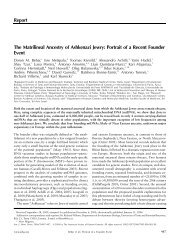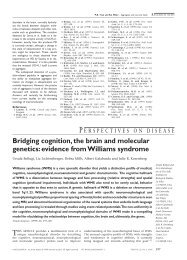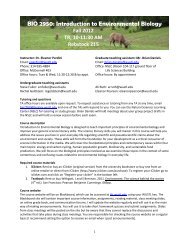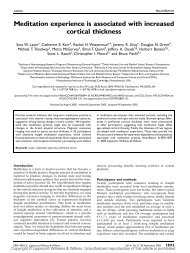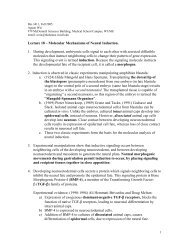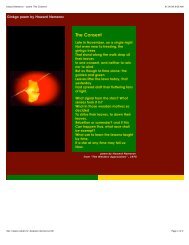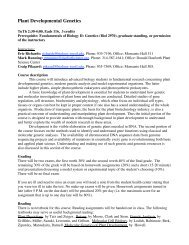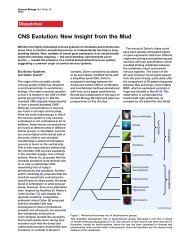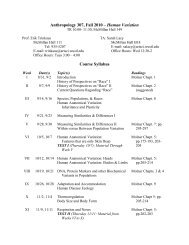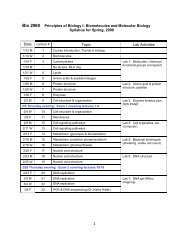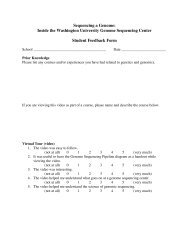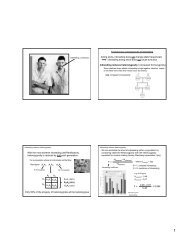The exceptional brain of Albert Einstein
The exceptional brain of Albert Einstein
The exceptional brain of Albert Einstein
Create successful ePaper yourself
Turn your PDF publications into a flip-book with our unique Google optimized e-Paper software.
Department <strong>of</strong> medical history<br />
<strong>The</strong> <strong>exceptional</strong> <strong>brain</strong> <strong>of</strong> <strong>Albert</strong> <strong>Einstein</strong><br />
Sandra F Witelson, Debra L Kigar, Thomas Harvey<br />
In recent decades, there have been major advances in<br />
neuroscience at the behavioural and neural levels, but<br />
the long-standing issue <strong>of</strong> the neurobiological basis <strong>of</strong><br />
variation in intelligence remains unresolved. 1 Around the<br />
turn <strong>of</strong> the 20th century, much attention was focused on<br />
anatomical correlates <strong>of</strong> intelligence through detailed<br />
necropsy case studies <strong>of</strong> the <strong>brain</strong>s <strong>of</strong> outstanding<br />
people, such as mathematician Karl F Gauss or<br />
physician William Osler. 2 , 3 By 1907, Spitzka 4 h a d<br />
published an extensive monograph that summarised 137<br />
case reports <strong>of</strong> notable men and women such as Bach<br />
and Descartes, and also presented one <strong>of</strong> the first group<br />
studies <strong>of</strong> nine scholars. Weight <strong>of</strong> the <strong>brain</strong> and patterns<br />
<strong>of</strong> gyral convolutions were usually examined.<br />
This early work had several limitations. First, medical<br />
and cognitive status at the time <strong>of</strong> death were <strong>of</strong>ten not<br />
known. Second, normal comparison groups were not<br />
available, so that the results were mainly idiosyncratic<br />
observations. Quantitative measurement was usually<br />
limited to the weight <strong>of</strong> the whole <strong>brain</strong>, and even its<br />
relation to intelligence remained unresolved. For<br />
example, novelist Ivan Turgenev’s <strong>brain</strong> weighed<br />
2012 g, 4 whereas the <strong>brain</strong> <strong>of</strong> author Anatole France was<br />
half the value (1017 g). 5 Third, work was based on the<br />
assumption that intelligence was a unitary homogeneous<br />
ability—even though different people varied greatly in<br />
their area <strong>of</strong> cognitive excellence. (According to current<br />
theories <strong>of</strong> intelligence, there are independent spheres or<br />
modules <strong>of</strong> cognitive ability. 6 ) Last, the studies had no<br />
a priori hypotheses as to the relation between structure<br />
and psychological function, since there was little<br />
knowledge about the cortical localisation <strong>of</strong> cognitive<br />
f u n c t i o n . 7<br />
After the horrific events <strong>of</strong> World War II, issues<br />
related to the neurobiological substrate <strong>of</strong> intelligence<br />
were considered with great caution, and research in this<br />
area dwindled. <strong>The</strong> development <strong>of</strong> computerised<br />
imaging technologies has made it possible to obtain<br />
quantitative measurements <strong>of</strong> <strong>brain</strong> anatomy in vivo with<br />
magnetic resonance scanning, and renewed attention has<br />
been directed to the investigation <strong>of</strong> structure-function<br />
relations in the general population. <strong>The</strong> studies have<br />
varied greatly in their methodology, and, although the<br />
results are inconsistent, they do point to a low, but<br />
statistically significant, positive correlation between <strong>brain</strong><br />
Lancet 1999; 353: 2149–53<br />
Department <strong>of</strong> Psychiatry and Behavioural Neurosciences,<br />
McMaster University, Hamilton, Ontario, Canada (S F Witelson PhD,<br />
D L Kigar, T Harvey MD)<br />
Correspondence to: Dr Sandra F Witelson, Department <strong>of</strong> Psychiatry<br />
and Behavioural Neurosciences, Faculty <strong>of</strong> Health Sciences,<br />
McMaster University, HSC 3G53, 1200 Main Street West, Hamilton,<br />
Ontario L8N 3Z5, Canada<br />
(e-mail: witelson@mcmaster.ca)<br />
DEPARTMENT OF MEDICAL HISTORY<br />
volume and IQ scores. 8 Further work is needed to<br />
reconcile these results with the inconsistent findings on<br />
<strong>brain</strong> weight in the earlier case reports. Brain volume<br />
and weight are not perfectly correlated, and imaging<br />
does not provide measures <strong>of</strong> <strong>brain</strong> weight.<br />
<strong>The</strong> case <strong>of</strong> <strong>Albert</strong> <strong>Einstein</strong><br />
Resolving the neurobiological substrate <strong>of</strong> intelligence<br />
may be facilitated by the comparison <strong>of</strong> extreme cases<br />
with control groups within the framework <strong>of</strong> specific<br />
hypotheses. <strong>Albert</strong> <strong>Einstein</strong> is one <strong>of</strong> the intellectual<br />
giants <strong>of</strong> recorded history, and the preservation <strong>of</strong> his<br />
<strong>brain</strong> provides the possibility <strong>of</strong> an important case study.<br />
Since <strong>Einstein</strong>’s death, there has been no report <strong>of</strong> the<br />
gross anatomy <strong>of</strong> his <strong>brain</strong>. Here we present the first<br />
such study.<br />
Our investigation <strong>of</strong> <strong>Einstein</strong>’s <strong>brain</strong> was guided<br />
theoretically on the basis <strong>of</strong> current information <strong>of</strong><br />
cortical localisation <strong>of</strong> cognitive functions. <strong>The</strong><br />
generation and manipulation <strong>of</strong> three-dimensional<br />
spatial images and the mathematical representation <strong>of</strong><br />
concepts would appear to be essential cognitive<br />
processes in the development <strong>of</strong> <strong>Einstein</strong>’s theory <strong>of</strong><br />
r e l a t i v i t y . 9 <strong>Einstein</strong>’s own description <strong>of</strong> his scientific<br />
thinking was that “. . . words do not seem to play any<br />
role”, but there is “associative play” <strong>of</strong> “more or less<br />
1 0<br />
clear images” <strong>of</strong> a “visual and muscular type”.<br />
Visuospatial cognition, 1 1 , 1 2 mathematical ideation, 1 1 a n d<br />
imagery <strong>of</strong> movement1 3 are mediated predominantly by<br />
right and left posterior parietal regions. We hypothesised<br />
that the parietal lobes in particular might show<br />
anatomical differences between <strong>Einstein</strong>’s <strong>brain</strong> and the<br />
<strong>brain</strong>s <strong>of</strong> controls.<br />
Preservation <strong>of</strong> <strong>Einstein</strong>’s <strong>brain</strong><br />
<strong>Einstein</strong> died from a ruptured aneurysm <strong>of</strong> the<br />
abdominal aorta in 1955 at the age <strong>of</strong> 76 years. His<br />
medical history has been well documented, and his<br />
biographies show that he was mentally adept to the end<br />
<strong>of</strong> his life. 9 Within 7 hours <strong>of</strong> death, his <strong>brain</strong> was<br />
removed at necropsy, fresh weight was measured,<br />
perfusion <strong>of</strong> 10% formalin by injection into the internal<br />
carotid arteries was carried out, and the whole <strong>brain</strong> was<br />
then freely suspended in 10% formalin for fixation and<br />
subsequent study. No significant neuropathology was<br />
seen on examination (gross or microscopic). After<br />
fixation, caliper measurements were made directly from<br />
the <strong>brain</strong>; calibrated photographs were taken <strong>of</strong> all views<br />
<strong>of</strong> the whole <strong>brain</strong> and <strong>of</strong> the dissected hemispheres; the<br />
cerebral hemispheres were cut into approximately 240<br />
blocks, each about 10 cm 3 ; and the location <strong>of</strong> the<br />
blocks was recorded on photographs. <strong>The</strong> blocks were<br />
embedded in celloidin, and histological sections were<br />
m a d e .<br />
THE LANCET • Vol 353 • June 19, 1999 2149
DEPARTMENT OF MEDICAL HISTORY<br />
Figure 1: Photographs taken in 1995 <strong>of</strong> five views <strong>of</strong> <strong>Einstein</strong>’s whole <strong>brain</strong> (meninges removed)<br />
A, superior; B, left lateral; C, right lateral; D, inferior; E, midsagittal view <strong>of</strong> the left hemisphere. <strong>The</strong> arrow in<br />
each hemisphere indicates the posterior ascending branch <strong>of</strong> the Sylvian fissure as it runs into (is confluent<br />
with) the postcentral sulcus (compare with figure 2). Consequently, there is no parietal operculum in either<br />
hemisphere. Scale bar, 1 cm.<br />
Although there is no record <strong>of</strong> his having made specific<br />
arrangements for post-mortem study <strong>of</strong> his <strong>brain</strong>,<br />
<strong>Einstein</strong> was sympathetic to the idea <strong>of</strong> his <strong>brain</strong> being<br />
studied. As reported in <strong>The</strong> New York Times in 1951, he,<br />
along with other physicists, underwent electroencephalographic<br />
recordings for research purposes. 1 4 He also<br />
“insisted that his <strong>brain</strong> should be used for research”. 1 5 A t<br />
the time <strong>of</strong> his death, the family requested a necropsy,<br />
which was done by pathologist Thomas Harvey, who<br />
took the initiative to remove the <strong>brain</strong> for scientific<br />
study. Consent was given by <strong>Einstein</strong>’s elder son, Hans<br />
<strong>Albert</strong> <strong>Einstein</strong>, 1 6 and by the executor <strong>of</strong> <strong>Einstein</strong>’s<br />
estate, Pr<strong>of</strong> Otto Nathan (ref 17, p 264).<br />
Control <strong>brain</strong> specimens<br />
<strong>The</strong> control group consisted <strong>of</strong> all the male specimens<br />
available at the time (n=35) in the Witelson Normal<br />
Brain Collection based at McMaster University. <strong>The</strong> key<br />
features <strong>of</strong> this collection are that the <strong>brain</strong>s are from<br />
research volunteers with normal neurological and<br />
psychiatric status (as judged by<br />
clinical history and medical<br />
assessments) and normal<br />
cognitive ability (as<br />
documented by research<br />
neuropsychological testing that<br />
included IQ assessment). 1 8 I n<br />
each case, informed consent<br />
with respect to testing and<br />
necropsy had been obtained.<br />
Mean Full Scale IQ score<br />
o n the Wechsler Adult<br />
Intelligence Scale 1 9 w a s<br />
1 1 6 (SD 9). Quantitative<br />
measures <strong>of</strong> <strong>Einstein</strong>’s <strong>brain</strong><br />
and this control group were<br />
compared; <strong>Einstein</strong>’s <strong>brain</strong> was<br />
also compared with a smaller<br />
age-matched subgroup (in the<br />
collection) <strong>of</strong> the 8 men aged<br />
65 years or more (mean 68) for<br />
<strong>brain</strong> measures known to<br />
change with advancing age.<br />
Although women have smaller<br />
<strong>brain</strong>s than men, 2 0 for purposes<br />
<strong>of</strong> descriptive analysis <strong>of</strong> gyral<br />
morphology, <strong>Einstein</strong>’s <strong>brain</strong><br />
was also compared with 56<br />
female <strong>brain</strong>s (the total<br />
number <strong>of</strong> female <strong>brain</strong>s in the<br />
same collection).<br />
M e a s u r e m e n t s<br />
Direct caliper measurements<br />
were made both from<br />
<strong>Einstein</strong>’s <strong>brain</strong> and from the<br />
control <strong>brain</strong>s. Other<br />
measurements were made from<br />
calibrated photographs. We<br />
measured baseline values for<br />
overall dimensions <strong>of</strong> the<br />
<strong>brain</strong>, including variables for<br />
which there are published data<br />
(eg, weight, corpus callosum<br />
s i z e 2 1 ); measures involving<br />
parietal regions important for<br />
visuospatial cognition and mathematical thinking; and,<br />
for comparison, measures <strong>of</strong> frontal and temporal<br />
regions. Statistically significant differences between<br />
<strong>Einstein</strong> and the control group were defined as those<br />
measures at least 2 SDs from the control mean.<br />
<strong>Einstein</strong>’s parietal lobes<br />
Figure 1 shows the set <strong>of</strong> photographs taken in 1955 <strong>of</strong><br />
the lateral, superior, inferior, and midsagittal views <strong>of</strong><br />
<strong>Einstein</strong>’s <strong>brain</strong>. <strong>The</strong> superior view (figure 1A) shows a<br />
relatively spherical <strong>brain</strong> which is corroborated<br />
quantitatively (see below). Moderate atrophy is present<br />
around the main fissures in the central regions in both<br />
hemispheres, to an extent common for a person in their<br />
eighth decade. 2 2 A unique morphological feature is<br />
visible in the lateral surface <strong>of</strong> each hemisphere which<br />
otherwise shows usual anatomy (figure 1B, 1C)—<br />
namely, the posterior ascending branch <strong>of</strong> the Sylvian<br />
fissure is confluent with the postcentral sulcus.<br />
Consequently, there is no parietal operculum (the<br />
2150 THE LANCET • Vol 353 • June 19, 1999
DEPARTMENT OF MEDICAL HISTORY<br />
anterior part <strong>of</strong> the supramarginal<br />
gyrus), which normally develops<br />
between these two sulci during fetal<br />
l i f e . 2 3 , 2 4 This morphology found in each<br />
<strong>of</strong> <strong>Einstein</strong>’s hemispheres was not seen<br />
in any hemisphere <strong>of</strong> the 35 control<br />
male <strong>brain</strong>s or <strong>of</strong> the 56 female <strong>brain</strong>s,<br />
nor in any specimen documented in the<br />
published collections <strong>of</strong> post-mortem<br />
2 5 , 2 6 b r a i n s .<br />
Figure 2 highlights this unique<br />
feature <strong>of</strong> <strong>Einstein</strong>’s <strong>brain</strong> in<br />
comparison with a typical control<br />
<strong>brain</strong>. Three main types <strong>of</strong> morphology<br />
<strong>of</strong> the Sylvian fissure and surrounding<br />
2 7<br />
gyri have been described previously;<br />
in each type, the Sylvian fissure<br />
terminates or bifurcates behind the<br />
postcentral sulcus, and the parietal<br />
operculum is present. <strong>The</strong> tracing <strong>of</strong><br />
the superimposed hemispheres <strong>of</strong> the<br />
control <strong>brain</strong> (figure 2, no 3) shows the<br />
typical right-left asymmetry in size and<br />
position <strong>of</strong> the Sylvian fissure and the<br />
parietal opercula. 2 8 By contrast, the<br />
tracing <strong>of</strong> <strong>Einstein</strong>’s hemispheres<br />
(figure 2, no 6) shows the confluence<br />
<strong>of</strong> the posterior ascending branch <strong>of</strong><br />
the Sylvian fissure and the postcentral<br />
sulcus in each hemisphere, the absence<br />
<strong>of</strong> the parietal opercula, and unusual<br />
symmetry between hemispheres <strong>of</strong><br />
sulcal morphology in this region.<br />
Quantitative measurements <strong>of</strong><br />
<strong>Einstein</strong>’s <strong>brain</strong> compared with the<br />
male control group are shown in the<br />
table, with relevant landmarks shown<br />
in figure 3. <strong>Einstein</strong>’s <strong>brain</strong> was not<br />
statistically different from the control<br />
group on most measures. His <strong>brain</strong><br />
weight did not differ from the control<br />
group, from the age-matched<br />
subgroup, or from published large agematched<br />
groups (table, measure 1).<br />
Unfortunately, the volume <strong>of</strong> <strong>Einstein</strong>’s<br />
<strong>brain</strong> had not been obtained. Brain length, height, size <strong>of</strong><br />
the corpus callosum, and measures <strong>of</strong> the frontal and<br />
temporal lobes did not differ between <strong>Einstein</strong> and<br />
controls. However, size <strong>of</strong> a specific gyral region in the<br />
frontal operculum was different in <strong>Einstein</strong>’s <strong>brain</strong> from<br />
that <strong>of</strong> the control group. <strong>The</strong> possible association <strong>of</strong> this<br />
feature in relation to biographical accounts <strong>of</strong> <strong>Einstein</strong>’s<br />
atypical speech development 1 7 will be reported elsewhere.<br />
By contrast, in the parietal lobes, there were striking<br />
quantitative differences. Each hemisphere <strong>of</strong> <strong>Einstein</strong>’s<br />
<strong>brain</strong> was 1 cm wider (15%) than that <strong>of</strong> the control<br />
group (measure 5). Maximum width usually occurs<br />
across the end <strong>of</strong> the Sylvian fissure—the region <strong>of</strong><br />
unique morphology in <strong>Einstein</strong>’s <strong>brain</strong>. <strong>The</strong> ratios <strong>of</strong><br />
hemisphere width to height and <strong>of</strong> <strong>brain</strong> width to length<br />
(measures 6 and 7) showed that in <strong>Einstein</strong>’s <strong>brain</strong> the<br />
parietal lobes were relatively wider and the <strong>brain</strong> more<br />
spherical (see figure 1A) than those in the control group.<br />
In <strong>Einstein</strong>’s <strong>brain</strong>, the parietal operculum was missing<br />
in each hemisphere in contrast to control values <strong>of</strong><br />
6 · 1 c m 2 and 3·6 cm 2 in the left and right hemispheres,<br />
Figure 2: Lateral photographs and tracings <strong>of</strong> left (solid line) and right (dashed line)<br />
superimposed hemispheres <strong>of</strong> a typical control male <strong>brain</strong> (1, 2, 3) and the <strong>brain</strong> <strong>of</strong><br />
<strong>Einstein</strong> (4, 5, 6)<br />
<strong>The</strong> photographs <strong>of</strong> the control <strong>brain</strong> show the parietal operculum in the left (stippled) and right<br />
(hatched) hemisphere, situated between the postcentral (PC) sulcus and the posterior ascending<br />
branch <strong>of</strong> the Sylvian fissure (SF), which originates at the point <strong>of</strong> bifurcation (●) and terminates at<br />
S. PC 1 is the inferior end <strong>of</strong> PC at SF. <strong>The</strong> tracing <strong>of</strong> the superimposed hemispheres (3) shows the<br />
asymmetry in position and size between the parietal opercula. <strong>The</strong> tracing <strong>of</strong> <strong>Einstein</strong>’s<br />
hemispheres (6) highlights the confluence <strong>of</strong> PC and the posterior ascending branch <strong>of</strong> SF in each<br />
hemisphere, the absence <strong>of</strong> the parietal opercula, and the symmetry <strong>of</strong> the sulcal morphology<br />
between hemispheres. Comparison <strong>of</strong> the tracings shows the relatively anterior position <strong>of</strong> the SF<br />
bifurcation in <strong>Einstein</strong>, and the associated greater posterior parietal expanse, particularly in his left<br />
hemisphere compared with the control <strong>brain</strong>.<br />
respectively (measure 24). Parietal regions typically<br />
s h o w anatomical asymmetry (table, control group,<br />
measures 19–24 2 8 ). <strong>Einstein</strong>’s parietal lobes were<br />
symmetrical (compare with figure 2, no 6). This was due<br />
mainly to his left parietal lobe being larger than<br />
u s u a l , resembling a right hemisphere in size and<br />
m o r p h o l o g y .<br />
D i s c u s s i o n<br />
<strong>The</strong> gross anatomy <strong>of</strong> <strong>Einstein</strong>’s <strong>brain</strong> was within normal<br />
limits with the exception <strong>of</strong> his parietal lobes. In each<br />
hemisphere, morphology <strong>of</strong> the Sylvian fissure was<br />
unique compared with 182 hemispheres from the 35<br />
control male and 56 female <strong>brain</strong>s: the posterior end <strong>of</strong><br />
the Sylvian fissure had a relatively anterior position,<br />
associated with no parietal operculum. In this same<br />
region, <strong>Einstein</strong>’s <strong>brain</strong> was 15% wider than controls.<br />
<strong>The</strong>se two features suggest that, in <strong>Einstein</strong>’s <strong>brain</strong>,<br />
extensive development <strong>of</strong> the posterior parietal lobes<br />
occurred early, 2 4 in both longitudinal and breadth<br />
dimensions, thereby constraining the posterior expansion<br />
THE LANCET • Vol 353 • June 19, 1999 2151
DEPARTMENT OF MEDICAL HISTORY<br />
<strong>Einstein</strong> Control group (mean, SD)<br />
Left Right Left Right<br />
Age (yr) 76 57 (11)<br />
Height (cm) 176 178 (8)<br />
Overall <strong>brain</strong> measures<br />
1 Brain weight, fresh (g) 1230 1400 (118)*<br />
2 Hemisphere weight, fixed (g) 550·0 545·0 591·0 (46·0) 591·0 (48·0)<br />
3 Maximum height <strong>of</strong> hemisphere 8·9 8·7 9·3 (0·6) 9·4 (0·6)<br />
(cm)†<br />
4 Length <strong>of</strong> hemisphere (OF) (cm) 17·2 16·4 16·9 (0·6) 16·8 (0·6)<br />
5 Maximum width <strong>of</strong> hemisphere 7·5§ 7·5§ 6·5 (0·5) 6·5 (0·5)<br />
(cm)‡<br />
6 Ratio <strong>of</strong> width <strong>of</strong> hemisphere to 0·84§ 0·86§ 0·70 (0·07) 0·69 (0·07)<br />
height<br />
7 Ratio <strong>of</strong> width <strong>of</strong> <strong>brain</strong> to length 0·89§ 0·77 (0·06)<br />
(mean OF)<br />
8 Corpus callosum area (cm 2 ) 6·8 7·0 (0·90)<br />
Frontal lobe (cm)<br />
9 F-PreC 9·2 9·5 9·4 (0·7) 9·2 (0·8)<br />
10 FC 11·3 11·6 10·6 (0·6) 10·5 (0·6)<br />
11 FA 5·1 5·1 4·8 (0·4) 4·7 (0·4)<br />
12 A-PreC 1 0·8 0·9 0·9 (0·4) 1·0 (0·4)<br />
13 PreC 1-C 1 1·2 1·2 1·4 (0·5) 1·2 (0·4)<br />
Temporal lobe (cm)<br />
14 TO 13·2 12·8 13·2 (0·5) 13·2 (0·5)<br />
15 C 1-C 2 3·9 3·9 4·0 (0·3) 4·0 (0·3)<br />
16 SS 1 6·1 6·6 5·1 (1·1) 6·0 (0·9)**<br />
Parietal/occipital lobe (cm)<br />
17 O-PC 8·4 7·9 8·3 (0·8) 8·4 (0·8)<br />
18 OC 8·9 8·3 9·5 (0·6) 9·3 (0·8)<br />
19 OB 7·1 7·9 5·8 (0·9) 7·2 (0·9)**<br />
20 OS 8·0 7·9 6·1 (1·1) 7·4 (1·0)**<br />
21 BS 2·5 2·9 0·9 (1·1) 2·4 (1·3)**<br />
22 C 1-PC 1 3·5§ 2·0 2·3 (0·6) 2·0 (0·6)**<br />
23 PC 1-B 0§ 0§ 1·9 (1·0) 1·1 (1·2)**<br />
24 Parietal operculum (cm 2 ) 0§ 0§ 6·1 (3·4) 3·6 (2·1)**<br />
Control group consists <strong>of</strong> 35 men and an age-matched male subgroup (see text).<br />
*Our control mean <strong>of</strong> 1400 g is similar to values <strong>of</strong> other studies <strong>of</strong> large groups <strong>of</strong><br />
white men <strong>of</strong> similar age range (30–70 years)—eg, mean fresh <strong>brain</strong> weight=1399 g,<br />
n=1433, mean age=53 years. 20 For the age-matched subgroup, mean (SD) fresh <strong>brain</strong><br />
weight was 1386 g (149). In a large study, mean fresh <strong>brain</strong> weight for a 70–80 year age<br />
group was 1342 g, n=253. 20<br />
†Maximum height usually occurs near the plane <strong>of</strong> point C (figure 3).<br />
‡Maximum width <strong>of</strong> each hemisphere occurs over the end <strong>of</strong> SF (figure 3).<br />
§Statistically different (2 SDs from the control group) or reflect unique morphology.<br />
Callosal area is larger in non-right-handers and decreases with advancing age. 21 <strong>The</strong>re<br />
is evidence to suggest that <strong>Einstein</strong> was not consistently right-handed. 37 <strong>Einstein</strong>’s<br />
callosal area <strong>of</strong> 6·8 cm 2 tended to be larger than his predicted value (5·9 cm 2 ) when<br />
hand preference and age were taken into account. 21<br />
**Statistically significant right-left anatomical asymmetry within the control group<br />
(compare ref 28) (p
R e f e r e n c e s<br />
1 Deary IJ, Caryl PG. Neuroscience and human intelligence<br />
differences. Trends Neurosci 1997; 2 0 : 3 6 5 – 7 1 .<br />
2 Wagner R. Vorstudien zu einer wissenschaftlichen: Morphologie und<br />
Physiologie des menschlichen Gehirns als Seelenorgan. Göttingen:<br />
Verlag der Dieterichschen Buchhandlung, I 1860; II 1862.<br />
3 Donaldson HH, Canavan MM. A study <strong>of</strong> the <strong>brain</strong>s <strong>of</strong> three<br />
scholars. J Comp Neurol 1928; 4 6 : 1 – 9 5 .<br />
4 Spitzka EA. A study <strong>of</strong> the <strong>brain</strong>s <strong>of</strong> six eminent scientists and<br />
scholars belonging to the American Anthropometric Society.<br />
Together with a description <strong>of</strong> the skull <strong>of</strong> Pr<strong>of</strong>essor E D Cope. T r a n s<br />
Am Philos Soc 1907; 2 1 : 1 7 5 – 3 0 8 .<br />
5 Gould SJ. <strong>The</strong> mismeasure <strong>of</strong> man. New York: W W Norton, 1981.<br />
6 Gardner H. Frames <strong>of</strong> mind: the theory <strong>of</strong> multiple intelligences.<br />
New York: Basic Books, 1983.<br />
7 Geschwind N. Disconnexion syndromes in animals and man. B r a i n<br />
1965; 8 8 : 2 3 7 – 9 7 .<br />
8 Wickett JC, Vernon PA, Lee DH. In vivo <strong>brain</strong> size, head perimeter,<br />
and intelligence in a sample <strong>of</strong> healthy adult females. Person Individ<br />
D i f f 1994; 1 6 : 8 3 1 – 3 8 .<br />
9 Pais A. <strong>Einstein</strong> lived here. Oxford: Clarendon Press, 1994.<br />
10. <strong>Einstein</strong> A. Cited in Hadamard J. <strong>The</strong> psychology <strong>of</strong> invention in the<br />
mathematical field. New Jersey: Princeton University Press,<br />
1 9 4 9 :1 4 2 – 4 3 .<br />
1 1 Critchley M. <strong>The</strong> parietal lobes. New York: Hafner Publications,<br />
1 9 7 1 .<br />
1 2 Tagaris GA, Kim S, Strupp JP, Andersen P, Ugurbil K,<br />
Georgopoulos AP. Quantitative relations between parietal activation<br />
and performance in mental rotation. Neurol Report 1996; 7 : 7 7 3 – 7 6 .<br />
1 3 Crammond DJ. Motor imagery: never in your wildest dreams. T r e n d s<br />
N e u r o s c i 1997; 2 0 : 5 4 – 5 7 .<br />
1 4 <strong>Einstein</strong>’s <strong>brain</strong>waves being recorded: geniuses aid test <strong>of</strong> <strong>brain</strong><br />
processes. <strong>The</strong> New York Times. February 24, 1951.<br />
1 5 Clark RW. <strong>Einstein</strong>: the life and times. New York: Thomas Crowell,<br />
1971: 630.<br />
1 6 Brian D. <strong>Einstein</strong>: a life. New York: Wiley & Sons, 1996: 437.<br />
1 7 Highfield R, Carter P. <strong>The</strong> private lives <strong>of</strong> <strong>Albert</strong> <strong>Einstein</strong>. New York:<br />
St Martin’s Press, 1993.<br />
1 8 Witelson SF, McCulloch PB. Premortem and postmortem<br />
measurement to study structure with function: a human <strong>brain</strong><br />
collection. Schizophr Bull 1991; 1 7 : 5 8 3 – 9 1 .<br />
1 9 Weschler D. Manual: Weschler Adult Intelligence Scale. New York:<br />
Psychological Corporation, 1955.<br />
DEPARTMENT OF MEDICAL HISTORY<br />
2 0 Dekaban AS, Sadowsky D. Changes in <strong>brain</strong> weights during the span<br />
<strong>of</strong> human life: relation <strong>of</strong> <strong>brain</strong> weights to body heights and body<br />
weights. Ann Neurol 1978; 4 : 3 4 5 – 5 6 .<br />
2 1 Witelson SF. Hand and sex differences in the isthmus and genu <strong>of</strong> the<br />
human corpus callosum: a postmortem morphological study. B r a i n<br />
1989; 1 1 2 : 7 9 9 – 8 3 5 .<br />
2 2 Tomlinson BE. Ageing and the dementias. In: Adams JH, Duchen<br />
LW, eds. Greenfield’s neuropathology, 5th edn. London: Edward<br />
Arnold, 1992.<br />
2 3 Chi JG, Dooling EC, Gilles FH. Gyral development <strong>of</strong> the human<br />
<strong>brain</strong>. Ann Neurol 1977; 1 : 8 6 – 9 3 .<br />
2 4 Fontes V. Morfologia do cortex cerebral (Desenvolvimento). Lisbon:<br />
Lisboa, 1944.<br />
2 5 Connolly CJ. External morphology <strong>of</strong> the primate <strong>brain</strong>. Springfield,<br />
IL: CC Thomas, 1950.<br />
2 6 Ono M, Kubik S, Abernathey CD. Atlas <strong>of</strong> the cerebral sulci. New<br />
York: George Thieme Verlag, 1990.<br />
2 7 Witelson SF, Kigar DL. Sylvian fissure morphology and asymmetry<br />
in men and women: bilateral differences in relation to handedness in<br />
men. J Comp Neurol 1992; 3 2 3 : 3 2 6 – 4 0 .<br />
2 8 Witelson SF, Kigar DL. Asymmetry in <strong>brain</strong> function follows<br />
asymmetry in anatomical form: gross, microscopic, postmortem and<br />
imaging studies. In: Boller F, Grafman J, eds. Handbook <strong>of</strong><br />
neuropsychology. Vol 1. Amsterdam: Elsevier Science, 1988.<br />
2 9 Van Essen DC. A tension-based theory <strong>of</strong> morphogenesis and<br />
compact wiring in the central nervous system. N a t u r e 1997; 3 8 5 :<br />
3 1 3 – 1 8 .<br />
3 0 Welker WI, Campos GB. Physiological significance <strong>of</strong> sulci in<br />
somatic sensory cerebral cortex in mammals <strong>of</strong> the family P r o c y o n i d a e .<br />
J Comp Neurol 1963; 120: 1 9 – 3 6 .<br />
3 1 Cajal S. Recollections <strong>of</strong> my life. London: MIT Press, 1989.<br />
3 2 Stevens CF. How cortical interconnectedness varies with network<br />
size. Neural Computation 1989; 1: 4 7 3 – 7 9 .<br />
3 3 Anderson B, Harvey T. Alterations in cortical thickness and neuronal<br />
density in the frontal cortex <strong>of</strong> <strong>Albert</strong> <strong>Einstein</strong>. Neurosci Lett 1 9 9 6 ;<br />
2 1 0 : 1 6 1 – 6 4 .<br />
3 4 Kigar DL, Witelson SF, Glezer II, Harvey T. Estimates <strong>of</strong> cell<br />
number in temporal neocortex in the <strong>brain</strong> <strong>of</strong> <strong>Albert</strong> <strong>Einstein</strong>. S o c<br />
Neurosci Abst 1997; 2 3 : no 89.9.<br />
3 5 Diamond MC, Scheibel AB, Murphy JGM, Harvey T. On the <strong>brain</strong><br />
<strong>of</strong> a scientist: <strong>Albert</strong> <strong>Einstein</strong>. Exp Neurol 1985; 8 8 : 1 9 8 – 2 0 4 .<br />
3 6 Hines T. Further on <strong>Einstein</strong>’s <strong>brain</strong>. Exp Neurol 1998; 150: 3 4 3 – 4 4 .<br />
3 7 Winokur M. <strong>Einstein</strong>: a portrait. Corte Madera, CA: Pomegranate<br />
Artbooks, 1984.<br />
THE LANCET • Vol 353 • June 19, 1999 2153



